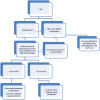The diagnosis and management of idiopathic intracranial hypertension and the associated headache
- PMID: 27366239
- PMCID: PMC4916517
- DOI: 10.1177/1756285616635987
The diagnosis and management of idiopathic intracranial hypertension and the associated headache
Abstract
Idiopathic intracranial hypertension (IIH) is a challenging disorder with a rapid increasing incidence due to a close relation to obesity. The onset of symptoms is often insidious and patients may see many different specialists before the IIH diagnosis is settled. A summary of diagnosis, symptoms, headache characteristics and course, as well as existing evidence of treatment strategies is presented and strategies for investigations and management are proposed.
Keywords: acetazolamide; headache; idiopathic intracranial hypertension; visual loss.
Conflict of interest statement
Figures



References
-
- Alsuhaibani A., Carter K., Nerad J., Lee A. (2011) Effect of optic nerve sheath fenestration on papilledema of the operated and the contralateral nonoperated eyes in idiopathic intracranial hypertension. Ophthalmology 118: 412–414. - PubMed
-
- Ball A., Howman A., Wheatley K., Burdon M., Matthews T., Jacks A., et al. (2011) A randomised controlled trial of treatment for idiopathic intracranial hypertension. J Neurol 258: 874–881. - PubMed
-
- Biousse V., Ameri A., Bousser M. (1999) Isolated intracranial hypertension as the only sign of cerebral venous thrombosis. Neurology 53: 1537–1542. - PubMed
Publication types
LinkOut - more resources
Full Text Sources
Other Literature Sources
Medical

